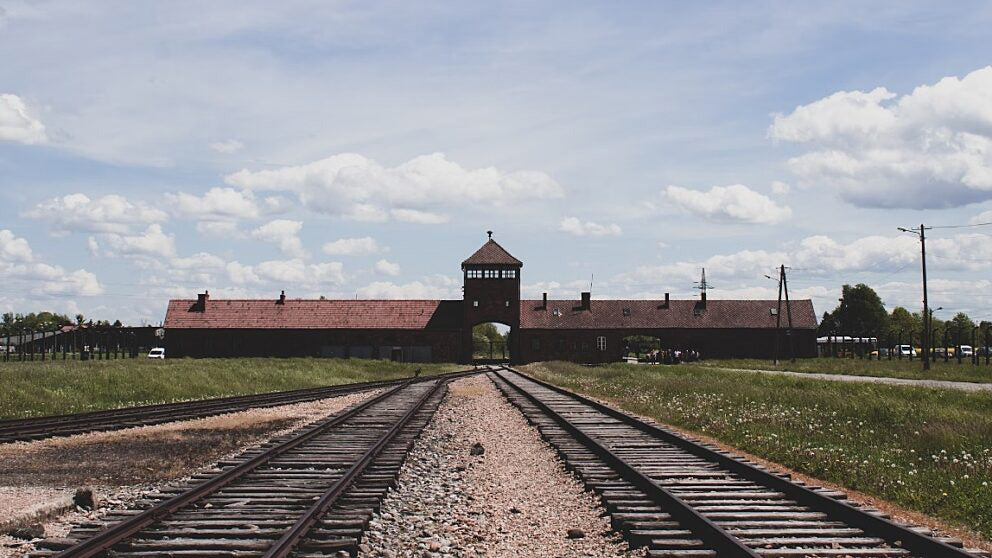On Holocaust Memorial Day (27 January) we commemorate the millions of victims of Nazi persecution, especially the six million Jewish men, women and children – some two thirds of Europe’s Jewish population – systematically killed between 1941 and 1945. We also remember the mass-murder of millions of others deemed ‘sub-human’ in the eyes of Nazi racial policy, including ethnic Poles, the disabled, Soviet citizens, gay men, Roma and Sinti, and political and religious dissidents.
In his 1952 novel Stalingrad the former Red Army war correspondent Vasily Grossman – whose Jewish mother was murdered at Babi Yar in September 1941 – would question how such outrages could happen, through the thoughts of his character Krymov, a Red Army Commissar:
‘One image troubled him day and night – the sight of the spattered blood and scraps of women’s clothing on the front of a German tank. How, he kept on asking, could this have happened? The driver, after all, was an ordinary soldier. No one had been giving him orders, nobody had been standing over him when, on the fringes of the Piluki Forest, he had turned his tank against defenceless women and children.’
Chillingly, the transcribed conversations of Axis POWs produced at Trent Park and the other CSDIC (UK) camps, do give some insight into this very question. A glimpse into the dark seething mass of racial hatred and twisted thinking that made the Holocaust possible.
‘There is only one people that must be exterminated: the Jews, who have wronged the whole world.’ – An unnamed Italian submarine officer, 29 November 1940. A reminder that the scale of the Holocaust would not have been possible without non-German collaboration
‘A great friend of mine whom I can trust implicitly, an Austrian still in Vienna, as far as I know, belong to ‘Luftflotte 4’, and was down in Odessa. When he arrived there some ‘Oberleutnant’ or ‘Hauptmann’ said to him: ‘Would you like to watch? An amusing show is going on there, umpteen Jews are being killed off.’ […] He said: ‘You can’t imagine what their screams sound like. Is such a thing right? […] I quite agree the Jews had to be turned out, that was obvious, but the manner in which it was done was absolutely done, and the present hatred is the result.’ – Oberst Erwin Jösting, 8 – 9 April 1945.
‘A senior police official actually told me about it in the train, that they shot thousands of Jewish men, women and children at Berdichev and Zhitomir [in Ukraine] he actually told me about it without my asking and he gave such a horrid and vivid description of it […] He told me about it with the businesslike calm of a professional murderer.’ – Oberst Hans Reimann, 19 December 1943.
‘All the Jews are mobilised against us, and the Jews are in possession of 80 percent of the wealth of the world.’ – An unnamed Italian Tenente di Vascello, 9 January 1941.
‘The Russians haven’t reached the spot yet where those large-scale mass murders took place, […] Yes, Russian and Polish Jews. That was what I was telling you about, how they did away with thousands of them, with all sorts of accompanying horrors. Katyn was child’s play in comparison.’ – Generalmajor Georg Neuffer, 2 February 1944. The Katyn massacre was the mass-execution of over 20,000 captured Polish military officers and intellectuals by the Soviet Union, April-May 1940.
For more information on Holocaust Memorial Day, please take a look at the Holocaust Memorial Day Trust website – www.hmd.org.uk
References & Further Reading:
Helen Fry, The Walls Have Ears: The Greatest Intelligence Operation of World War II (New Haven: Yale University Press, 2019).
Alex Henry, War Through Italian Eyes: Fighting for Mussolini, 1940 – 1943 (Routledge: Abingdon, 2021).
Sönke Neitzel, Tapping Hitler’s Generals: Transcripts of Secret Conversations, 1942 – 45 (Barnsley: Frontline Books, 2007).
Sönke Neitzel, and Harald Welzer, Soldaten: On Fighting, Killing and Dying (London: Simon & Schuster, 2013)
News, Articles & Events
Remembering the Holocaust

